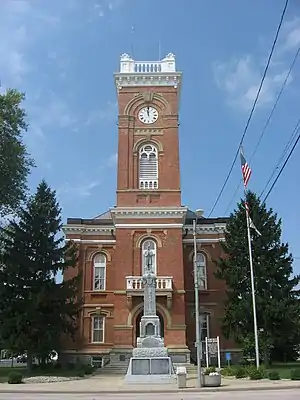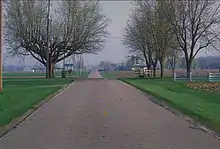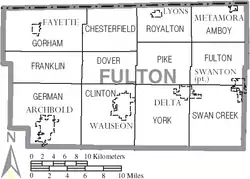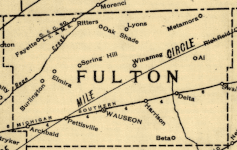Fulton County, Ohio
Fulton County is a county located in the U.S. state of Ohio west of Toledo. As of the 2010 census, the population was 42,698.[2] Its county seat is Wauseon.[3] The county was created in 1850 with land from Henry, Lucas, and Williams counties[4] and is named for Robert Fulton, inventor of the steamboat.[5]
Fulton County | |
|---|---|
 | |
 Seal | |
 Location within the U.S. state of Ohio | |
 Ohio's location within the U.S. | |
| Coordinates: 41°36′N 84°07′W | |
| Country | |
| State | |
| Founded | April 1, 1850[1] |
| Named for | Robert Fulton |
| Seat | Wauseon |
| Largest city | Wauseon |
| Area | |
| • Total | 407 sq mi (1,050 km2) |
| • Land | 405 sq mi (1,050 km2) |
| • Water | 1.8 sq mi (5 km2) 0.4%% |
| Population | |
| • Estimate (2019) | 42,126 |
| • Density | 105/sq mi (41/km2) |
| Time zone | UTC−5 (Eastern) |
| • Summer (DST) | UTC−4 (EDT) |
| Congressional district | 5th |
| Website | www |

Fulton County is part of the Toledo Metropolitan Area.
History
The first seat of justice in Fulton County was Ottokee, located there because of its central location in the county. A wooden courthouse was built in 1851.[6]
However, a railroad was built further south. Wauseon sprung up in 1854 when the railroad was extended to that point, and incorporated in 1859.[7] With the commercial success that the railroad brought to Wauseon, the citizens of the county voted to move the county seat to Wauseon in 1871.[6] The Fulton County Courthouse was built in 1872.[8]
Geography
According to the U.S. Census Bureau, the county has a total area of 407 square miles (1,050 km2), of which 405 square miles (1,050 km2) is land and 1.8 square miles (4.7 km2) (0.4%) is water.[11]
Adjacent counties
- Lenawee County, Michigan (north)
- Lucas County (east)
- Henry County (south)
- Williams County (west)
- Hillsdale County, Michigan (northwest)
Protected Areas
Demographics
| Historical population | |||
|---|---|---|---|
| Census | Pop. | %± | |
| 1850 | 7,781 | — | |
| 1860 | 14,043 | 80.5% | |
| 1870 | 17,789 | 26.7% | |
| 1880 | 21,053 | 18.3% | |
| 1890 | 22,023 | 4.6% | |
| 1900 | 22,801 | 3.5% | |
| 1910 | 23,914 | 4.9% | |
| 1920 | 23,445 | −2.0% | |
| 1930 | 23,477 | 0.1% | |
| 1940 | 23,626 | 0.6% | |
| 1950 | 25,580 | 8.3% | |
| 1960 | 29,301 | 14.5% | |
| 1970 | 33,071 | 12.9% | |
| 1980 | 37,751 | 14.2% | |
| 1990 | 38,498 | 2.0% | |
| 2000 | 42,084 | 9.3% | |
| 2010 | 42,698 | 1.5% | |
| 2019 (est.) | 42,126 | [12] | −1.3% |
| U.S. Decennial Census[13] 1790-1960[14] 1900-1990[15] 1990-2000[16] 2010-2019[2] | |||
2000 census
As of the census[17] of 2000, there were 42,084 people, 15,480 households, and 11,687 families living in the county. The population density was 104 people per square mile (40/km2). There were 16,232 housing units at an average density of 40 per square mile (15/km2). The racial makeup of the county was 95.65% White, 0.24% Black or African American, 0.26% Native American, 0.42% Asian, 0.04% Pacific Islander, 2.31% from other races, and 1.08% from two or more races. 5.76% of the population were Hispanic or Latino of any race.
There were 15,480 households, out of which 37.10% had children under the age of 18 living with them, 63.20% were married couples living together, 8.20% had a female householder with no husband present, and 24.50% were non-families. 21.10% of all households were made up of individuals, and 9.40% had someone living alone who was 65 years of age or older. The average household size was 2.69 and the average family size was 3.13.
In the county, the population was spread out, with 28.30% under the age of 18, 7.70% from 18 to 24, 28.70% from 25 to 44, 22.60% from 45 to 64, and 12.70% who were 65 years of age or older. The median age was 36 years. For every 100 females there were 95.60 males. For every 100 females age 18 and over, there were 93.30 males.
The median income for a household in the county was $44,074, and the median income for a family was $50,952. Males had a median income of $36,180 versus $25,137 for females. The per capita income for the county was $18,999. About 4.00% of families and 5.40% of the population were below the poverty line, including 6.10% of those under age 18 and 4.60% of those age 65 or over.
2010 census
As of the 2010 United States Census, there were 42,698 people, 16,188 households, and 11,942 families living in the county.[18] The population density was 105.3 inhabitants per square mile (40.7/km2). There were 17,407 housing units at an average density of 42.9 per square mile (16.6/km2).[19] The racial makeup of the county was 94.9% white, 0.4% black or African American, 0.4% Asian, 0.3% American Indian, 2.4% from other races, and 1.5% from two or more races. Those of Hispanic or Latino origin made up 7.8% of the population.[18] In terms of ancestry, 45.5% were German, 11.9% were Irish, 10.7% were English, 6.9% were Polish, and 6.2% were American.[20]
Of the 16,188 households, 34.6% had children under the age of 18 living with them, 59.8% were married couples living together, 9.3% had a female householder with no husband present, 26.2% were non-families, and 22.3% of all households were made up of individuals. The average household size was 2.61 and the average family size was 3.05. The median age was 39.9 years.[18]
The median income for a household in the county was $50,717 and the median income for a family was $59,090. Males had a median income of $42,561 versus $30,070 for females. The per capita income for the county was $22,804. About 8.5% of families and 10.5% of the population were below the poverty line, including 14.4% of those under age 18 and 5.4% of those age 65 or over.[21]
Politics
For over 80 years, Fulton County has regularly voted for Republican candidates for president. The only Democrats to win Fulton were Franklin Pierce in 1852 and Franklin D. Roosevelt in his 1932 election.
| Year | Republican | Democratic | Third parties |
|---|---|---|---|
| 2020 | 69.0% 15,731 | 29.2% 6,664 | 1.8% 411 |
| 2016 | 64.2% 13,709 | 28.4% 6,069 | 7.4% 1,575 |
| 2012 | 55.1% 11,738 | 42.6% 9,073 | 2.3% 499 |
| 2008 | 53.1% 11,689 | 45.0% 9,900 | 1.9% 424 |
| 2004 | 62.1% 13,640 | 37.5% 8,224 | 0.4% 90 |
| 2000 | 61.1% 11,546 | 36.0% 6,805 | 2.9% 545 |
| 1996 | 48.6% 8,703 | 37.2% 6,662 | 14.2% 2,542 |
| 1992 | 44.5% 8,358 | 29.7% 5,576 | 25.9% 4,870 |
| 1988 | 66.3% 10,230 | 32.9% 5,076 | 0.8% 122 |
| 1984 | 72.6% 11,412 | 26.8% 4,217 | 0.6% 101 |
| 1980 | 64.7% 9,519 | 27.0% 3,972 | 8.3% 1,216 |
| 1976 | 60.9% 7,891 | 37.5% 4,850 | 1.6% 208 |
| 1972 | 68.6% 8,387 | 29.6% 3,615 | 1.9% 232 |
| 1968 | 64.1% 7,817 | 27.4% 3,338 | 8.5% 1,033 |
| 1964 | 51.6% 5,973 | 48.4% 5,604 | |
| 1960 | 74.8% 9,695 | 25.2% 3,274 | |
| 1956 | 77.5% 9,030 | 22.5% 2,622 | |
| 1952 | 78.2% 9,191 | 21.8% 2,565 | |
| 1948 | 70.7% 6,523 | 29.0% 2,672 | 0.4% 35 |
| 1944 | 79.4% 8,258 | 20.6% 2,147 | |
| 1940 | 77.4% 8,653 | 22.6% 2,530 | |
| 1936 | 60.2% 6,152 | 35.0% 3,582 | 4.8% 490 |
| 1932 | 48.0% 4,487 | 50.0% 4,673 | 2.0% 184 |
| 1928 | 77.7% 6,416 | 21.7% 1,788 | 0.6% 49 |
| 1924 | 69.6% 4,951 | 18.7% 1,333 | 11.7% 834 |
| 1920 | 73.9% 6,111 | 24.8% 2,049 | 1.3% 111 |
| 1916 | 53.0% 2,933 | 45.3% 2,507 | 1.8% 97 |
| 1912 | 17.6% 929 | 34.3% 1,805 | 48.1% 2,531 |
| 1908 | 61.2% 3,608 | 36.2% 2,131 | 2.6% 153 |
| 1904 | 69.1% 3,593 | 27.9% 1,448 | 3.0% 157 |
| 1900 | 59.5% 3,457 | 38.9% 2,262 | 1.6% 92 |
| 1896 | 56.0% 3,227 | 42.8% 2,464 | 1.3% 73 |
| 1892 | 55.3% 2,808 | 37.8% 1,919 | 6.8% 347 |
| 1888 | 55.7% 2,901 | 38.4% 1,997 | 5.9% 308 |
| 1884 | 56.9% 2,848 | 38.0% 1,904 | 5.1% 253 |
| 1880 | 60.7% 2,912 | 37.2% 1,787 | 2.1% 102 |
| 1876 | 62.0% 2,697 | 36.7% 1,597 | 1.3% 57 |
| 1872 | 71.6% 2,210 | 26.8% 826 | 1.7% 52 |
| 1868 | 65.4% 2,171 | 34.6% 1,150 | |
| 1864 | 66.9% 1,953 | 33.1% 968 | |
| 1860 | 61.6% 1,629 | 37.2% 984 | 1.1% 30 |
| 1856 | 56.8% 1,098 | 39.9% 772 | 3.3% 64 |
Transportation
Airport
Fulton County Airport is a public use airport located four nautical miles (5 mi, 7 km) north of the central business district of Wauseon, Ohio. It is owned by the Fulton County Commissioners.[24]
Communities

City
- Wauseon (county seat)
Census-designated places
References
- "Ohio County Profiles: Fulton County" (PDF). Ohio Department of Development. Archived from the original (PDF) on 2007-06-21. Retrieved 2007-04-28.
- "State & County QuickFacts". United States Census Bureau. Archived from the original on June 6, 2011. Retrieved February 7, 2015.
- "Find a County". National Association of Counties. Archived from the original on 2011-05-31. Retrieved 2011-06-07.
- "Archived copy". Archived from the original on 2018-03-28. Retrieved 2018-03-28.CS1 maint: archived copy as title (link)
- Gannett, Henry (1905). The Origin of Certain Place Names in the United States. Govt. Print. Off. pp. 133.
- Aldrich, Lewis Cass (1888). History of Henry and Fulton counties, Ohio : with illustrations and biographical sketches of some of its prominent men and pioneers. Syracuse, N. Y.: D. Mason & Co., Publishers. pp. 288–289.
- Reighard, Frank H. (1920). A Standard History of Fulton County, Ohio (Volume 1). Lewis Publishing Company. p. 209.
- Hellmann, Paul T. (May 13, 2013). Historical Gazetteer of the United States. Routledge. p. 876. ISBN 978-1135948597. Retrieved 30 November 2013.
- Railroad & township map of Ohio (Map). Library of Congress. 1851. Retrieved 11 April 2016.
- J. A. Norton, Ohio commissioner of railroads & telegraphs (1890). Railroad map of Ohio (Map). Retrieved 11 April 2016.
- "2010 Census Gazetteer Files". United States Census Bureau. August 22, 2012. Archived from the original on May 4, 2014. Retrieved February 7, 2015.
- "Population and Housing Unit Estimates". Retrieved March 26, 2020.
- "U.S. Decennial Census". United States Census Bureau. Retrieved February 7, 2015.
- "Historical Census Browser". University of Virginia Library. Retrieved February 7, 2015.
- Forstall, Richard L., ed. (March 27, 1995). "Population of Counties by Decennial Census: 1900 to 1990". United States Census Bureau. Retrieved February 7, 2015.
- "Census 2000 PHC-T-4. Ranking Tables for Counties: 1990 and 2000" (PDF). United States Census Bureau. April 2, 2001. Retrieved February 7, 2015.
- "U.S. Census website". United States Census Bureau. Retrieved 2008-01-31.
- "DP-1 Profile of General Population and Housing Characteristics: 2010 Demographic Profile Data". United States Census Bureau. Archived from the original on 2020-02-13. Retrieved 2015-12-27.
- "Population, Housing Units, Area, and Density: 2010 - County". United States Census Bureau. Archived from the original on 2020-02-13. Retrieved 2015-12-27.
- "DP02 SELECTED SOCIAL CHARACTERISTICS IN THE UNITED STATES – 2006-2010 American Community Survey 5-Year Estimates". United States Census Bureau. Archived from the original on 2020-02-13. Retrieved 2015-12-27.
- "DP03 SELECTED ECONOMIC CHARACTERISTICS – 2006-2010 American Community Survey 5-Year Estimates". United States Census Bureau. Archived from the original on 2020-02-13. Retrieved 2015-12-27.
- Leip, David. "Dave Leip's Atlas of U.S. Presidential Elections". uselectionatlas.org. Retrieved 2018-05-02.
- "Ohio Historical Election Results". Retrieved January 21, 2021.
- FAA Airport Form 5010 for USE PDF. Federal Aviation Administration. effective May 31, 2012.



.svg.png.webp)